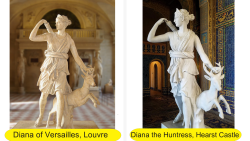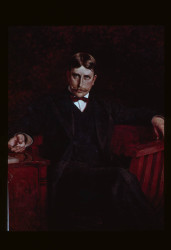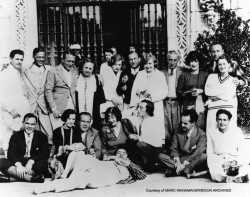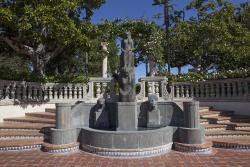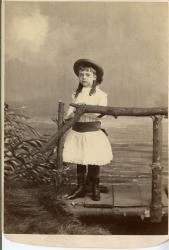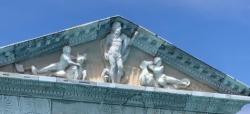<p></p>
<p>Adapted From <a data-v-18e7a463="" href="https://learninglab.si.edu/collections/ancient-civilizations/8AcIWXhl7TSPDrzu#r">Ancient Civilizations</a> Last Modified April 03, 2021 Description</p>
<p></p>
<p></p>
<p>William Randolph Hearst was a wealthy media mogul who developed a love of art at a young age. His father was a successful miner and his mother was an art collector and generous philanthropist. After his mother took him on a year-and-a-half-long tour of Europe when he was 10 years old, he developed a lasting love of art and antiquities. He collected original works of art as well as copies all throughout his life. He wrote Julia Morgan, the architect of Hearst Castle, a letter in 1927 that stated he saw no reason why San Simeon could not become a museum of the finest things he could secure. His dream became a reality in 1957 when his estate in San Simeon, California was gifted to the State of California. Hearst Castle has many fine examples of Egyptian, Greek, and Roman art. In this unit, you will see some of the antiquities and copies he purchased during his lifetime. You will also be able to take a look at the history behind the art in his collection.</p>
<p>Each slide/image will appear with the yellow paperclip icon. This will include extra info, questions, or hotspots. <strong>Hit the "i" icon on each slide to read information about the image</strong>. After reading the information and observing the slides, students will be able to evaluate primary and secondary sources while gathering information for their research and presentations. Also listed are some activities from<a href="http://pz.harvard.edu/thinking-routines"> Project Zero</a>, a research group from Harvard Graduate School of Education whose focus is learning through the arts. They have developed simple activities that encourage careful observation, promote thoughtful interpretations, stimulate curiosity, and set the stage for inquiry.</p>
<p>Below are a few "Thinking Routines" which are a set of questions or a brief sequence of steps used to scaffold and support student thinking.</p>
<p><strong>"See – Think -Wonder"</strong></p>
<p>This routine encourages students to make careful observations and thoughtful interpretations. It helps stimulate curiosity and sets the stage for inquiry by asking students to consider the following questions:</p>
<ol><li>What do you see?</li><li>What do you think about that?</li><li>What does it make you wonder?</li></ol>
<p>(Students can write down their answers on paper or share orally with a partner.)</p>
<p><strong>"Ten Times Two"</strong></p>
<p>This routine helps students slow down and make careful observations about the art. Ask students to think about words or phrases to describe the work and encourage students to push beyond the first observation and look again.</p>
<ol><li>Look at the image.</li><li>List 10 words or phrases about what you see.</li><li> Look again and try to add 10 more words or phrases to your list.</li></ol>
<p></p>
<p><strong>"Apples to Apples"</strong></p>
<p>This routine allows students to observe closely the images in this unit from the castle. Students are able to include their own experience in deciding which words best describe the art.</p>
<ol><li>Go through the images in this unit and pair together what word best describes each image: balance, grandeur, power, happiness, teamwork, security, equality, inspiration, compassion, serenity, symmetry, splendor, movement, and athletics. </li></ol>
<p><br><strong>"Beginning, Middle, End"</strong></p>
<p>This routine uses the power of narrative to help students make observations and encourages them to use their imagination to elaborate on and extend their ideas. Its emphasis on storytelling also encourages students to look for connections, patterns, and meanings<strong>.</strong><br>Choose one of these questions:<br></p>
<p>If this artwork is the beginning of a story, what might happen next? </p>
<p>If this artwork is the middle of a story, what might happen before? What might be about to happen? </p>
<p>If this artwork is the end of a story, what might the story be?<br><br><br>Keywords: Egyptian goddess, Egyptian New Kingdom, diorite, Sekhmet, Sun god Ra, sarcophagus, muses, tapestries, Guilio Romano, Scipio, Carthaginians, Second Punic War, Corinthian capital, Doric capital, Ionic capital, entablature, pediment, temple, Apollo, Artemus, Hephaestus, attributes, lyre, Carrara marble, Discobolus, Amphora, Greek vessel, King Tutankhamen, Queen Hatshepsut, Queen Nefertiti, Pharaoh Akhenaten, solar disk, monotheism, polytheism, Roman baths, composite, Europa, Zeus, Talos, Laelaps, 18th Dynasty, 19th Dynasty, lagobolon, plectrum, kithara, griffin, aguila, eagle.</p>
<p></p>
<p><br></p>
<p></p>
<p><strong><br></strong></p>
<ol></ol>
<ul></ul>
<p><br>.</p>
<p></p>
<p></p>
<p></p>
<p></p>
<p><span class="Apple-converted-space"><br></span></p>
<p><span class="Apple-converted-space">©Hearst Castle®/CA State Parks. May not be reproduced without advance written permission from Hearst Castle<br></span></p>

Hearst Castle® & Hearst San Simeon State Historical Monument
11
 Hearst Castle® & Hearst San Simeon State Historical Monument
Hearst Castle® & Hearst San Simeon State Historical Monument
 Hearst Castle® & Hearst San Simeon State Historical Monument
Hearst Castle® & Hearst San Simeon State Historical Monument
 Hearst Castle® & Hearst San Simeon State Historical Monument
Hearst Castle® & Hearst San Simeon State Historical Monument
 Hearst Castle® & Hearst San Simeon State Historical Monument
Hearst Castle® & Hearst San Simeon State Historical Monument
 Hearst Castle® & Hearst San Simeon State Historical Monument
Hearst Castle® & Hearst San Simeon State Historical Monument

